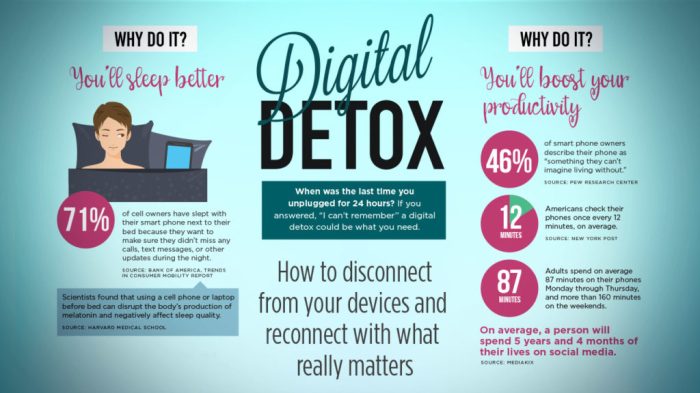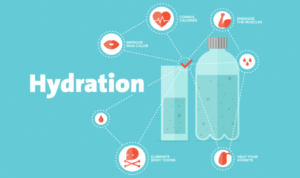Starting with digital detox methods, let’s dive into effective ways to disconnect from screens and focus on real-life experiences. From setting boundaries with technology to engaging in offline activities, explore how these methods can enhance your well-being.
Discover the benefits of disconnecting, practical tips for reducing screen time, and engaging activities to replace screen time. Learn how to create a personalized digital detox plan for a healthier relationship with technology.
Benefits of Digital Detox

Taking a break from digital devices can have numerous advantages for our mental health and overall well-being. Constant exposure to screens can lead to increased stress, anxiety, and even sleep disturbances. By disconnecting from the digital world, individuals can experience improved mood, better sleep quality, and reduced feelings of overwhelm.
Improved Mental Health
Reducing screen time through a digital detox can significantly impact mental health. Constant notifications, social media comparisons, and information overload can contribute to feelings of inadequacy and anxiety. Disconnecting allows individuals to focus on themselves, practice mindfulness, and engage in activities that promote relaxation and inner peace.
Enhanced Productivity and Focus
One of the key benefits of digital detox is the improvement in productivity and focus. Constant multitasking and distractions from digital devices can hinder our ability to concentrate on tasks at hand. By taking a break, individuals can enhance their concentration, creativity, and problem-solving skills. This can lead to increased efficiency in work or academic tasks, resulting in a more fulfilling and successful day.
Methods for Digital Detox: Digital Detox Methods
In today’s digital age, it can be challenging to disconnect from screens and technology. However, incorporating digital detox methods into our daily routines is crucial for our mental and physical well-being. By setting boundaries with technology use, we can reduce screen time and improve our overall quality of life.
1. Unplug Before Bed
One effective method for digital detox is to unplug from all devices at least an hour before bedtime. The blue light emitted from screens can interfere with our sleep patterns, making it harder to fall asleep. Instead, try reading a book, meditating, or practicing relaxation techniques before bed.
2. Create Tech-Free Zones
Designate certain areas of your home as tech-free zones, such as the dining room or bedroom. By setting boundaries on where technology is allowed, you can create spaces for relaxation and social interaction without the distractions of screens.
3. Take Screen Breaks
Incorporate regular screen breaks throughout your day to give your eyes and mind a rest. Set a timer to remind yourself to take a break every hour and engage in activities like stretching, going for a walk, or simply looking away from your screen to reduce eye strain.
4. Practice Mindfulness
Mindfulness techniques, such as meditation and deep breathing exercises, can help you become more aware of your technology use and its impact on your well-being. By practicing mindfulness, you can learn to be present in the moment and reduce your dependence on screens.
5. Set Technology Boundaries
Establish clear boundaries with technology use, such as limiting screen time during meals or turning off notifications during designated quiet times. By setting boundaries, you can regain control over your digital habits and create a healthier balance between technology and real-life experiences.
Activities to Replace Screen Time

In today’s digital age, it’s important to find alternative activities to reduce screen time and promote a healthier lifestyle. Engaging in offline activities can enhance creativity and social interactions.
Hobbies to Try Instead of Using Digital Devices
- Reading a Book: Dive into a good book to stimulate your mind and imagination.
- Art and Crafts: Get creative with painting, drawing, or crafting projects.
- Outdoor Activities: Take a hike, go for a bike ride, or play a sport to stay active.
- Cooking or Baking: Experiment in the kitchen and whip up delicious meals or treats.
Benefits of Engaging in Offline Activities
- Enhanced Creativity: Offline activities can spark creativity and inspire new ideas.
- Improved Social Interactions: Spending time away from screens allows for more meaningful connections with others.
- Reduced Stress: Engaging in hobbies can help reduce stress and promote relaxation.
- Physical Health: Outdoor activities and hands-on hobbies contribute to better physical health.
Creating a Digital Detox Plan
To successfully detox from digital devices, it’s essential to create a personalized plan that suits your lifestyle and needs. By setting clear goals and timelines, you can ensure a more effective detox experience.
Setting Goals for Your Detox
- Start by identifying the reasons why you want to detox from digital devices. Whether it’s to reduce screen time, improve sleep quality, or enhance productivity, having clear goals will keep you motivated.
- Set specific and achievable goals, such as limiting screen time to a certain number of hours per day or avoiding digital devices during specific times, like before bedtime.
- Write down your goals and keep them somewhere visible to remind yourself why you’re undergoing a digital detox.
Creating a Weekly Detox Schedule, Digital detox methods
- Plan out your week in advance and schedule dedicated time slots for activities that don’t involve screens, such as reading a book, going for a walk, or practicing mindfulness.
- Include breaks throughout the day where you disconnect from all digital devices and engage in offline activities.
- Set specific timelines for your detox, such as starting with a weekend detox and gradually extending it to weekdays.


